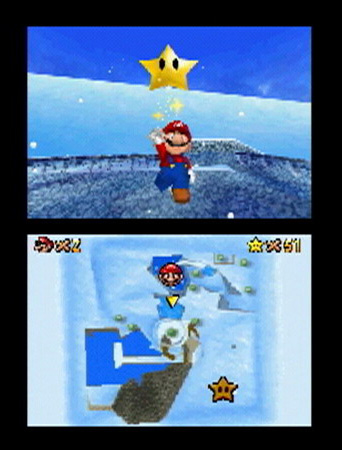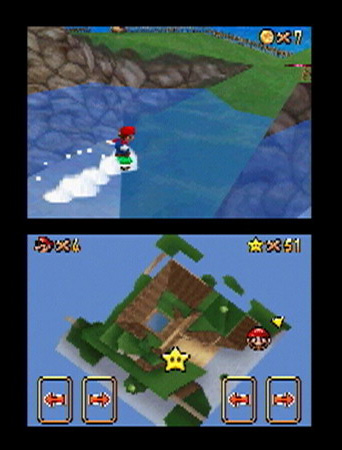Today, polygonal gaming is a given. We've advanced through a few generations of 3D gaming hardware, and generally speaking, 3D graphics are in a pretty good spot right now. But when polygonal games were first delivered to the masses, it was a huge paradigm shift that not only affected the way we looked at games, but also the way we played them. Systems that could portray large, more realistic 3D environments used to cost thousands of dollars, but were now on sale for $299 or less in the form of the PlayStation and the Nintendo 64, among others. In 1996, Nintendo released Super Mario 64, the game that rewrote the book for the platforming genre, and in many ways, console gaming in general. It's one of the greatest games of all time...and now you can fit an updated version of that game into your hip pocket with the release of Super Mario 64 DS. Though the game's controls will take some getting used to, the addition of some new areas and new playable characters make the adventure feel fresh, and some inventive minigames give you a pretty great reason to use the system's stylus.

Nintendo has been rereleasing its Mario games for its handheld systems for years, most recently via the Super Mario Advance series on the Game Boy Advance. Now that trend has carried over to the DS. Super Mario 64 DS is, essentially, the same game that was released back in 1996, though a few new twists and turns have been added. Though the game still opens with Peach inviting Mario to her castle (where she subsequently is kidnapped), you don't actually play as Mario right off the bat. Mario now shows up for the party with Wario and Luigi in tow, and the three of them enter the castle and promptly vanish. Yoshi, who has been sleeping on top of the castle (which is actually where he was hidden in the original game), wakes up, notices that everything seems just a little too quiet, and sets off to find the missing characters.
At this point, the game sets off as you'd expect if you've played the original, with Yoshi hopping around, jumping into paintings, and collecting power stars. Yoshi controls almost identically to Mario, though instead of Mario's three-hit combo attack, Yoshi can stick out his tongue and swallow enemies whole, turning them into eggs that you can toss at other enemies. Eventually, you'll find Mario, Luigi, and Wario, and you'll be able to switch between them whenever you like. Aside from Yoshi's tongue attack, the characters control almost identically. Luigi and Yoshi can jump a bit higher; Wario's punch is powerful enough to break bricks that the others can't dent; and Mario is the only character that can triangle-jump off of walls. Also, the game's flower power-up has a different effect on each of the four characters, and this sort of replaces the switch blocks from the original game, which gave Mario access to different hats with different effects. When you collect a flower with Mario, he inflates like a balloon and you can float around for a brief period of time; Yoshi gains the ability to breathe fire; Wario turns into metal when he grabs the flower, making him invincible, but also giving him the occasionally required ability to walk underwater on the floors of lakes and other bodies of water; and Luigi turns invisible for a brief period, which also gives him the ability to walk through some obstacles. Since some stars require specific power-ups, you'll occasionally have to swap in another character to get the job done.
The original Mario 64 relied heavily on the N64's analog joystick, so Mario 64 DS gives you a few different control options that attempt to emulate the control in different ways. By default, the game is configured to let you play without using the system's touch screen. The D pad is used for movement, and the buttons are used for jumping, ducking, attacking, and running. While you can also use the touch screen for running, the other two control modes are somewhat better suited for use with the touch screen, letting you shuffle the buttons around a bit to give you more control over your character. Although the three options do a decent job of letting you control your character, none of them are quite as refined as the analog joystick that was used to control Mario back in the original game. The D pad's digital nature makes moving with it rather imprecise. It attempts to make up for the lack of refinement by being a little more momentum-based, but you'll still find yourself running off of ledges more often than you'd like. Using the touch screen really isn't much better. You'll have full analog control over your movement, but changing directions isn't as fluid as it should be. The control issues aren't insurmountable, but it's a bummer that the game doesn't control as well as the original. Super Mario 64 is a game that requires a lot of precision movements, and it's unfortunate that none of the available control options are quite up to the task.
Mario 64 DS puts on a great show from a graphical standpoint. This time around, the character models have an increased poly count that makes them look much, much better than the eight-year-old N64 game after which it is modeled. You'll still run across an ugly texture or two, but the game runs at a great, smooth frame rate and looks bright and colorful. The rough spots are also smoothed out a bit by the fact that you're playing it on a small, sharp screen instead of a television. The map on the lower screen is a little fuzzy in spots and isn't quite as easy to read as it should be, but it works. The graphics used in the minigames are also quite strong.
Super Mario 64 was an amazing game back when it was originally released. For the most part, the game holds up pretty well, though there are a few head-scratchers that may have players wondering how we ever got by back then. The camera in the game isn't so hot. While you have the option to rotate the camera manually or center it behind your character, you still have to spend quite a lot of time controlling it to make sure you're getting a proper view of the action. Also, some of the stars you're trying to collect are devilishly difficult to find, to the point that unless you remember the original game very well (or throw up your hands and read a FAQ from the original game), you'll have to run around levels like a maniac, hoping that you stumble upon the solution. One level in particular has you launch yourself out of a cannon at a specific, unmarked section of a specific, unmarked wall, which will then break apart and reveal a star. The only clue you're given is the objective's title, "blast away the wall." The section of wall is pretty small, so even if you had the bright idea of getting in the cannon and firing yourself at the two or three walls that are in direct view of the cannon, you still might not hit the right spot, and then you'll just give up. This can make for some extremely frustrating moments if you still aren't familiar with the original game.
The DS's touch screen is used to display a top-down map of the current area. Points of interest, like stars, are highlighted on the map. The map actually makes many of the game's stars much easier to find, unlike the aforementioned goal with the cannon. If a star is out in the open, it will appear on the map, making it pretty easy to grab. Each level also has eight red coins, which can be collected for--yes, that's right--yet another star. Coins don't always show up on the map, but if you track down a bob-omb buddy in each level, he'll let you see the coins on the map for a brief period of time. Some of those objects are pretty difficult to find without the map, and its inclusion does serve to make the game a bit easier.
While the gameplay has its share of spots that haven't aged so well overall, and the control isn't perfect, Super Mario 64 DS is still a lot of fun. It's a huge game with large, colorful environments, and it pulls off some neat tricks and presents you with interesting and compelling puzzles. The game also contains a handful of new areas to explore, though many of these smaller areas really aren't all that interesting. The core game and the fights against Bowser are still the stars of the show here.
If you're near three other DS users, you can play a competitive four-player mode. This mode only requires you to have one game card, taking advantage of the system's wireless game download feature to transmit the necessary data to the other systems. Unfortunately, the multiplayer is a pretty uneventful competition, where the goal is to be the player holding the most stars when time expires. So you will battle against the other three players, getting them to drop stars and collecting them for yourself whenever possible. There are only a few different multiplayer levels to choose from, and by and large, this whole mode feels like an afterthought. It's a nice extra and a great chance to check out the DS's wireless multiplayer, but it isn't something worth going back to again and again.
Also in the extras category are a series of stylus-oriented minigames. You'll start out with eight games, but as you play through the adventure you'll be able to find and catch rabbits, each of which gives up a key that unlocks another new minigame. The minigames are varied, fun, and addictive. Each one usually revolves around one specific activity, such as using the stylus to draw back a slingshot and fire shots at parachuting bob-ombs floating down from the top screen, drawing lines that become trampolines to keep three Marios bouncing around from screen to screen, or even playing a game of Memory at Luigi's casino.

Super Mario 64 DS retains the same music and speech samples used in the original game, though some new samples were added for the new characters and a few effects have changed. Stomping an enemy now makes a more standard, Super Mario Bros.-like "stomp on a goomba" noise, instead of the higher-pitched squeak used in the original game. The tunes are extremely memorable, and even if you don't already have nostalgic feelings, you'll still come away humming many of the game's themes. Just about the only downside is that some of the effects sound slightly tinny and they're played back at a low bit rate, so they don't sound as clear as they could have. These effects are extra noticeable when using headphones. On the upside, the game's stereo separation is very noticeable, and it does a good job of making you appreciate the system's stereo speakers.
All things considered, Super Mario 64 DS is a great update of a classic game. While some portions of the game have aged better than others, and while the control could've been a little tighter, the game is done right enough to make it a faithful update for fans of the original; new players will certainly find a lot to like here, as well. This is clearly and deservedly the flagship game for the Nintendo DS launch.



